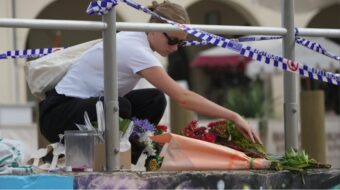OAKLAND – Bowing to intense pressure from the community and public officials, Oakland police remained largely on the sidelines as more than a thousand demonstrators, May 12, reasserted their constitutional right to picket at the docks against companies profiteering from the occupation of Iraq.
Samantha Hynes, an Oakland High School student, told the World the demonstration shows the Oakland Police Department (OPD) and Mayor Jerry Brown “that we’re not scared, that we will not be silenced.”
Oakland police brutally attacked peaceful anti-war protesters and longshore workers waiting on the sidelines to go to work last month. Dressed in para-military gear, they fired wooden bullets, shot-filled bags and concussion grenades, injuring nine longshoremen and 50 demonstrators, several seriously enough to require surgery.
But on May 12 the demonstrators marched on city and port streets to the beat of a brass band – behind banners that read, “No war at home, no war for empire” and “Stop the corporate invasion of Iraq” – as Oakland police looked attentively from the sidewalk or in parked vehicles. Occasionally longshore workers or truckers would let out a blast from their vehicles’ horns in support as marchers passed by.
Shipping lines appeared to be on the defensive as well. A vessel, originally scheduled for work at the American President Lines (APL) terminal at the time of the protest, was held in the San Francisco Bay until later. Both APL and Stevedoring Services of America (SSA), were the target of picketers charging them with profiteering from the war. These companies have been accused by labor and community representatives of conspiring with OPD at a private meeting, which laid out their battle plan for the April 7 attack.
Both the city’s mayor and Police Chief Richard Word continue to defend the use of excessive force on April 7, but appear to have moderated OPD procedures – for the moment at least. Police were not wearing their riot helmets, and their representatives and protest picket captains negotiated the entry of a few trucks destined for other terminals.
Vice Mayor Nancy Nadel told the World that three days earlier the police chief was compelled to meet with a large delegation from “Direct Action to Stop the War,” other peace groups, labor and community representatives to make sure police would not show up for the protest in “full battle gear” and that lines of communication would be open.
The month-long public outcry linked the waterfront incident with on-going police abuse in working class communities, particularly against people of color. As a result, Oakland City Council members are exploring ways to link the work of the independent panel they recently created to investigate the April 7 police attack at the docks with the functions of the Citizens Police Review Board, which community groups are demanding be given legal teeth by guaranteeing a full set of impartial commissioners and adequate funding and staffing.
The author can be reached at ncalview@igc.org









